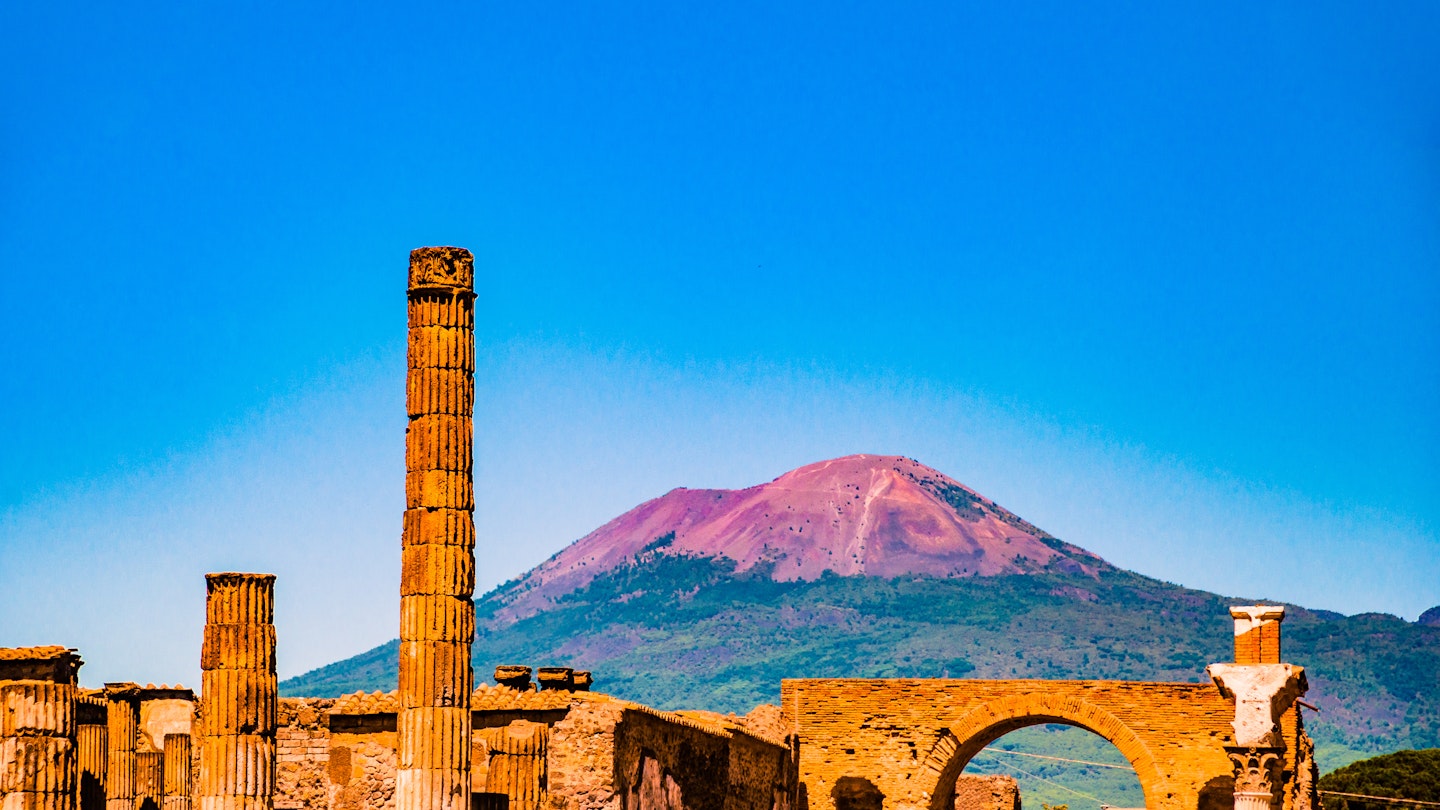Discovering the Ancient Ruins of Pompeii
Ancient Pompeii is one of Italy’s most haunting sights. Streets of skeletal ruins stretch into the distance while Mt Vesuvius broods darkly on the horizon, reminding visitors of the tragic eruption in 79 CE, which decimated the local population and buried the city under a thick layer of volcanic debris.
This article delves into Pompeii’s rich history, its catastrophic end, and its modern resurrection as one of the world’s most significant archaeological sites.
What Was Pompeii Like Before the Eruption?
Situated on the Bay of Naples in the southern Italian region of Campania, Pompeii was initially founded by an Italic tribe known as the Osci. Over the centuries, it passed through the hands of the Greeks, Etruscans, and Samnites, ultimately becoming part of the Roman world in the 1st century BCE.
Due to its favorable location near the mouth of the river Sarno, Pompeii thrived as a trading port. Goods from the fertile interior were exported while spices, silk, slaves, and wild animals were imported from across the Roman Empire.
By the 1st century CE, Pompeii’s population had reached approximately 20,000, showcasing the trappings of a prosperous Roman city, which included an amphitheater, forum, basilica, several temples, and public fountains. Luxurious holiday villas adorned the nearby coastline, further emphasizing the city’s affluence.
Inhabitants of Pompeii resided in crowded housing blocks, with streets lined by shops, bakeries, snack bars (known as thermopolia), shrines, taverns, and brothels.

The Eruption of Vesuvius
Even prior to the dramatic eruption of Vesuvius, 1st-century Pompeii was a precarious place. In 62 CE, the city was severely impacted by a major earthquake, and many structures were still undergoing repairs when the volcano erupted on 24 August 79.
This date is traditionally cited as the moment of disaster based on an eyewitness account from Pliny the Younger to the historian Tacitus. However, recent archaeological evidence has suggested that October might be a more accurate date.
The eruption’s intensity was catastrophic, beginning with a deafening boom that marked the volcano’s initial assault. A massive cloud of volcanic ash propelled 9 miles (14 km) skyward, shortly followed by a downpour of ash and lapilli (burning pumice stone) upon the city. This led to widespread structural collapses and trapped many inhabitants indoors.
As night fell, six lethal pyroclastic surges (waves of superheated gas and ash) swept through the area, raising ground temperatures to 572°F (300°C), resulting in the immediate deaths of those in their path.
Ultimately, by the time the eruption subsided, around 2,000 individuals had lost their lives, leaving Pompeii buried under 20 feet (6 meters) of hardened debris and effectively erasing it from existence.

Excavations of Pompeii
The underground ruins were initially uncovered by architect Domenico Fontana in 1594 while digging a canal, although significant excavations did not commence until 1748.
As news of these discoveries traveled across Europe, Pompeii evolved into a notable destination on the Grand Tour, attracting treasure seekers eager to collect frescoes, mosaics, sculptures, and scrolls.
Systematic excavations persisted through the 19th century, leading to the creation of chilling body casts, which were produced by pouring liquid plaster into the voids left by decomposed victims.
A more recent initiative, called the Great Pompeii Project, commenced in 2012 and brought together a team of around 200 international specialists, including archaeologists, art restorers, computer scientists, dentists, and radiologists.
Their collaborative efforts yielded remarkable findings, including the unveiling of an erotic fresco in 2018 that depicts the myth of Leda and the Swan. In early 2020, the renowned Casa degli Amanti (House of Lovers) was opened to the public for the first time in decades.

Pompeii Highlights
Villa dei Misteri
This restored 90-room villa showcases the Dionysiac frieze, one of the most important frescoes on-site, illustrating the initiation of a bride into the cult of Dionysius.
Casa del Poeta Tragico
The 1st-century House of the Tragic Poet is notable for the world’s first “Beware of the Dog” sign, marked by a mosaic featuring a fierce dog alongside the Latin phrase Cave Canem.
Terme Stabiane
The 2nd-century BCE Terme represents one of the oldest existing complexes of Roman baths, featuring a typical layout with an apodyterium (changing room), tepidarium (warm bath), and calidarium (hot bath).
Casa del Fauno
Among the largest private residences in Pompeii, this 2nd-century BCE villa is famed for its remarkable treasures, including the large mosaic of Alexander the Great and the Persian king Darius, currently exhibited at Naples’ Museo Archeologico Nazionale. The exquisite Casa del Menandro is another well-preserved villa worth exploring.
Lupanare
Pompeii’s brothel consisted of a compact two-story structure with five rooms on the ground floor, featuring erotic frescoes serving as a menu of sorts.
Anfiteatro
Dating back to 70 BCE, the oldest Roman amphitheater still in existence could accommodate up to 20,000 spectators.
Orto dei Fuggiaschi
Once a vineyard, this site features the plaster casts of 13 victims who tragically succumbed while attempting to escape the eruption.

Visiting Pompeii
Pompeii is open from 9 am to 7 pm, Tuesday to Sunday, with the last entry at 5:30 pm. The ticket prices are €16 for adults, €10 for younger visitors aged 18 to 25 during specific entry hours. To enhance your experience, it is advisable to arrive early and allocate about three hours for the visit.
Direct trains operated by Circumvesuviana connect the site (Pompei Scavi-Villa dei Misteri) to Naples (35 minutes) and Sorrento (30 minutes). It is essential to wear comfortable walking shoes, and during the summer months, a hat is recommended. Don’t forget to bring drinking water to stay hydrated while exploring this remarkable archaeological site.
In addition to Pompeii, consider exploring nearby Herculaneum and Naples’ Museo Archeologico Nazionale, where many of Pompeii’s most notable artefacts are displayed.




